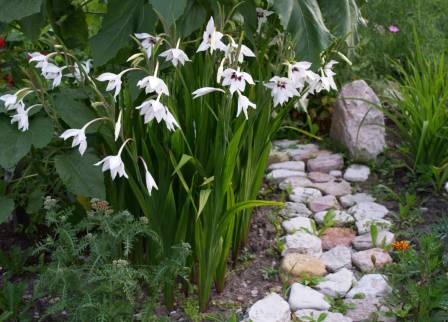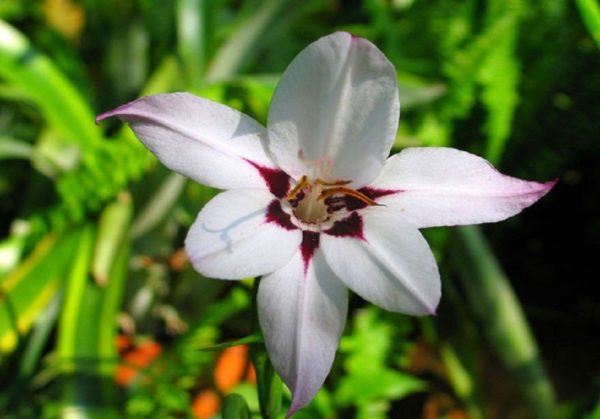
Acidanthera, fragrant gladiolus, gladiolus Muriel, fennel Muriel - a charming and rare plant still in Russian gardens. Growing and caring for acid acid in the open ground have their own difficulties, but this does not stop gardeners, the plant is confidently gaining ground.
Outwardly, it really looks like a gladiolus and is its closest relative. It attracts attention with xiphoid dense foliage, which allows you to create a bright vertical spot and dramatic, but at the same time graceful, like butterflies, white flowers with an ink-violet spot in the center. Below is all about planting, care, storage of acidaceans.
Content
Description
The plant belongs to the iris family, the genus is gladiolus, and the species is the gladiolus Muriel. More recently, he was attributed to the independent genus Acidanthera, so in the literature you can sometimes find discrepancies. The bulbous flower of the acidifier was given the foreign name in honor of Lady Muriel Agnes Stewart Erskine (1879-1967), who belonged to one of the oldest families in Scotland.
The herbaceous plant has a corm. Suitable for outdoor and indoor. The height of an adult specimen can reach 1 meter. The leaves are xiphoid, wide, up to 60 cm long. Each bulb has two leaves, but usually the plants are grown in a group. Peduncles long, thin, up to 1.5 meters high. The flowers are quite large, from 5 to 8 cm in diameter, soaring, collected in an inflorescence of up to 10 flowers. The outer part of the petals is snow-white, closer to the base there is a contrasting spot, the color of which can vary from dark crimson to ink violet or almost black. The flower has the shape of a butterfly, the petals are strongly pointed to the ends.
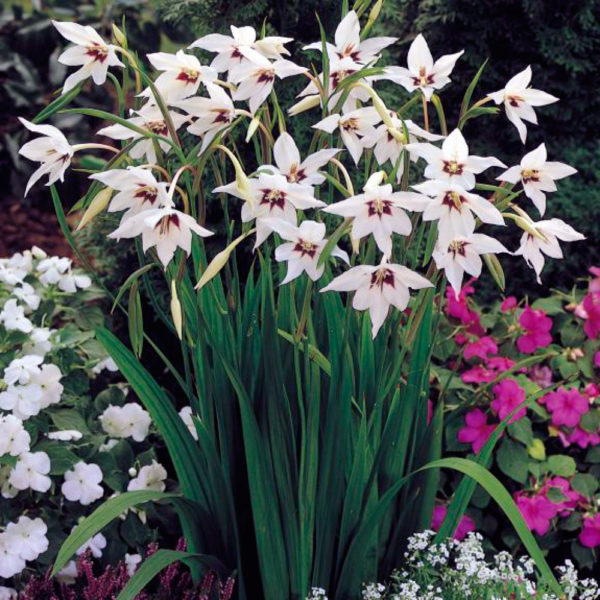
Note! Sometimes florists ask why fragrant gladiolus does not smell. The strength of the odor varies from species to species, the aroma can be light, barely noticeable. But, in any case, fragrant gladiolus emits an aroma, unlike ordinary gladioli. The smell is not strong, but very pleasant and original, slightly resembling jasmine. Attractive to bees. There is a hybrid of adidants with gladiolus, called a glanter; it has a weaker smell.
Bulb selection and presowing
It is better to buy planting material in domestic nurseries, Dutch bulbs may be too tender.
How to store acidicanter bulbs before planting? Disassembled bulbs before planting are treated with fungicides in order to avoid further damage by root rot, kept at a temperature of + 22 ° C for 2 weeks.

Immediately before planting, it makes sense to withstand the bulbs for several hours in any growth stimulator (Epin, Zircon).
Outdoor landing
Any soil is suitable for the plant, the main thing is to provide good drainage. Planting and caring for the acidella Mariela (murielae, two-color, white) will be easier if you immediately choose light, fertile neutral, slightly acidic or neutral soils. Planted only in well-warmed soil.
Between adult bulbs maintain a distance of 20 cm, close up to a depth of about 10 cm.A little river sand is added to each well. After planting, water well.
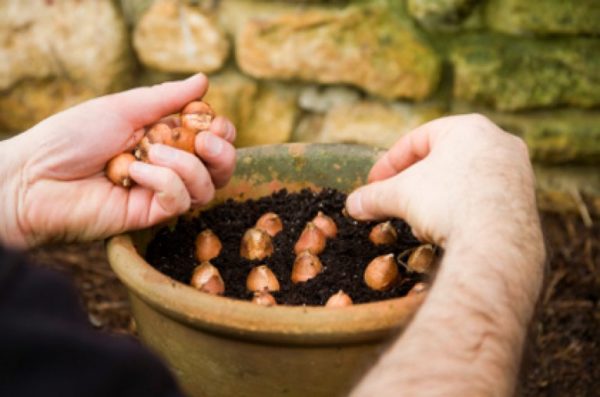
Perhaps the germination of bulbs before planting in open ground. This method has its advantages:
- The plant will be stronger and more resilient.
- Flowering will come faster and will be longer.
- When planting, you can immediately calibrate the plants for quality.
For germination in early March, plant bulbs in peat cups up to 15 cm, to a depth of 3-4 cm. Optimal - 1 onion - 1 pot, but 3-5 bulbs can be placed in a 15-cm container. They put it in a warm, and, most important, well-lit place (in the middle lane, backlighting in February-early March is mandatory). Provide cultivation and care, like any other seedlings. Gentle seedlings are watered regularly by the drip method, provide access to fresh air without drafts. A month before landing, they gradually accustom themselves to fresh air. When steady heat sets in, plants are planted directly in the ground without disturbing the root system.
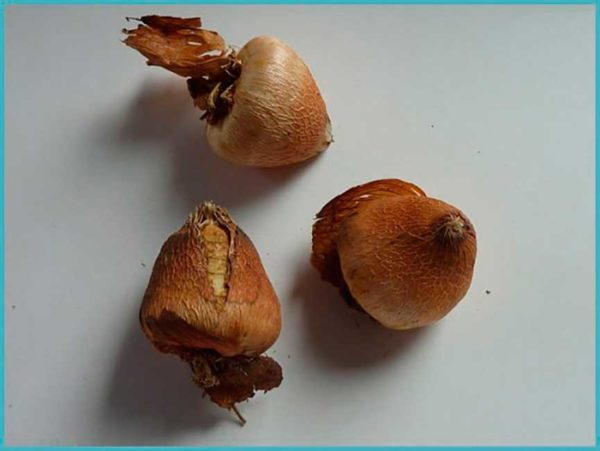
Features of outdoor care
Cultivation and care in the open field for acidanthera are not very different from the agricultural technology of gladioli. The main difficulty is how to keep the acidaceans onions until spring, the rest does not cause much trouble for gardeners.
Watering
Acidanthera bicolor loves plentiful, but moderate watering. What does this mean? The plant should receive a lot of moisture, but the bay is unacceptable. Loose, moisture-intensive soil and good drainage will relieve most of the problems associated with watering. The rest should focus on the condition of the soil and the weather. In a dry summer, daily watering may be required, it is unacceptable that the soil around the plant is dry - the bulbs will dry out quickly enough, the plant will weaken.
With the beginning of flowering, watering is slightly reduced to get brighter, contrasting flowers, but still continue to monitor the receipt of a sufficient amount of moisture.
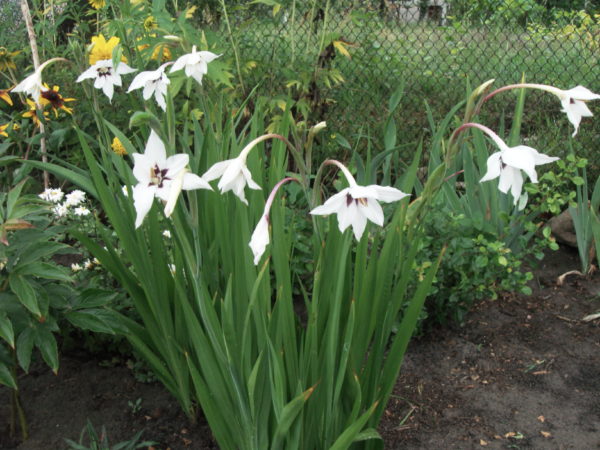
Loosening and weeding
Regularly remove weeds around the plant, they can become a breeding ground for pests, loosen the soil to prevent too quick drying of the soil, especially if the summer is dry and hot. Mulching the soil can be a good move, allowing you to simultaneously get rid of weeds and retain moisture in the soil. Not to mention that it gives an additional decorative effect. Mulch from crushed cones, bark, wood chips, rotted sawdust, peat, small gravel, granite chips looks beautiful.
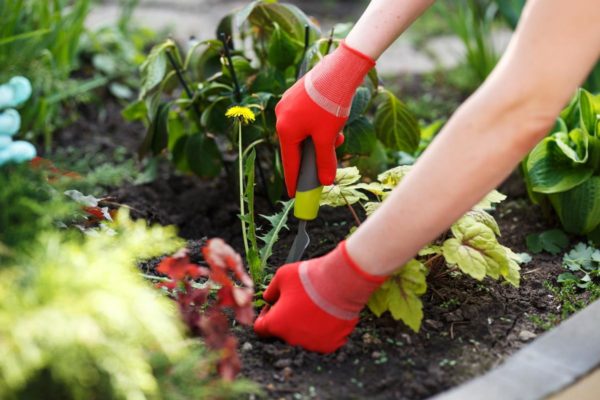
Top dressing
The plant is not too moody in terms of nutrition. If it was planted in a fresh, nutritious soil, with good care it will not need any fertilizer. But support will not hurt, especially if there is reason to think that the soil is poor. The interval between dressings is chosen at your discretion. Usual dates: 1 time per month, 1 time in two weeks, 1 time in 10 days (for especially poor, stony soils). During the flowering period, it is advisable to feed with complex mineral fertilizers 1 time per week.
Dosages are usually indicated on the packaging of the drug.
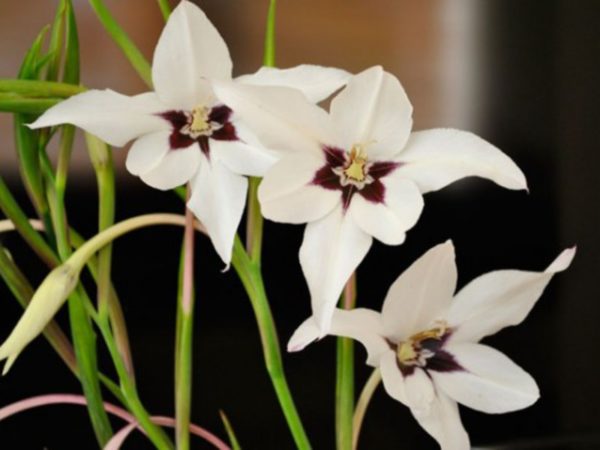
Other events
Care for acidanthera in the fall includes the timely removal of wilted buds - this will prolong flowering. You can spill the plant with a solution of potassium permanganate, 5 g per 10 liters of water, especially if the weather in the autumn is unstable, cold, with frequent prolonged rains. With severe cold and damp plants, it is better to dig up earlier.
When exactly to dig out and how to store acid acid? Consider below.
Wintering
Do I need to dig an acidantra for the winter? If your region has warm winters and the soil does not freeze, you can leave the bulbs in the soil, you just need to mulch the surface. And be sure to monitor the drainage - so that during spring flood the delicate bulbs do not get wet.
Preparation of acidants for winter in the middle lane involves digging. The natural habitat of fragrant gladiolus is Africa (Burundi, Ethiopia, Tanzania). It tolerates temperatures below zero negatively, so they dig out the bulbs in the middle lane for the winter.
They dig an acidantra in the same way as gladioli - with a decent lump of earth, so as not to damage the kids. Fading plants are given time to accumulate nutrients in the bulb, then, without waiting for the first frosts, they dig along with the leaves. The period of excavation and winter care depends on the region - approximately the end of September, October, beginning of November.
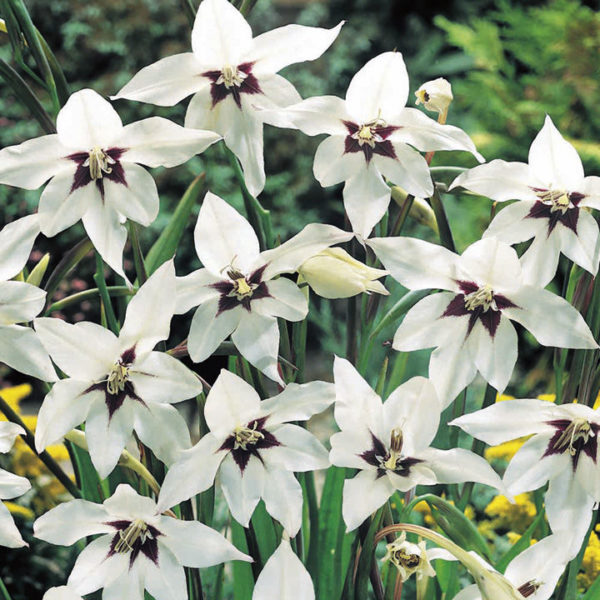
The general scheme is the preparation for winter:
- Dig bulbs, cut the stems, leaving a stump 2 cm long.
- Separate the kids.
- How to store acidifier immediately after digging? Planting material should be dried. Dry in a dry shaded place at a temperature of 20-22 ° C. Duration - about 1 month.
- They clean planting material from the remains of roots and leaves - they all easily disappear if the drying was of high quality.
How to store acidicanter bulbs in winter? The dried material is laid out in peat or wrapped in paper napkins, laid out in boxes with good ventilation, or bags with holes, kept in a dry, dark place at a temperature of + 15 ° C.
That is, storage of bulbs of acidants in the winter can be successful at home in an ordinary apartment.
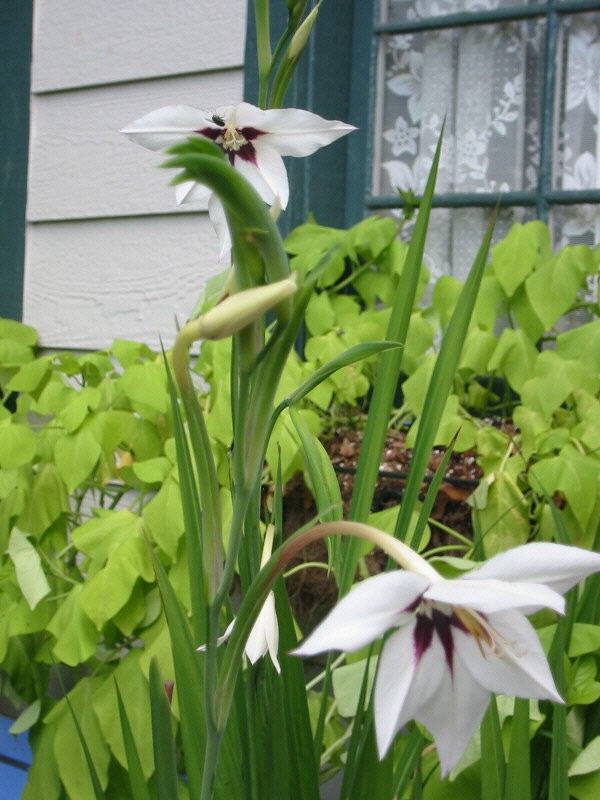
Breeding
- propagated vegetatively and by seeds;
- bulbs.
Like regular gladiolus, a fragrant representative of the same genus reproduces well by children. They are separated in the fall when digging from the mother bulbs. In the spring, they are planted together with adult specimens, observing the general rules for planting bulbs: the depth of planting = the height of the bulbs, the distance between plants = the diameter of the bulbs. In the early years, one should not expect flowers from young plants; they will bloom in 3-4 years. If the flowers appear, it is better to remove them to give the plant gain strength.
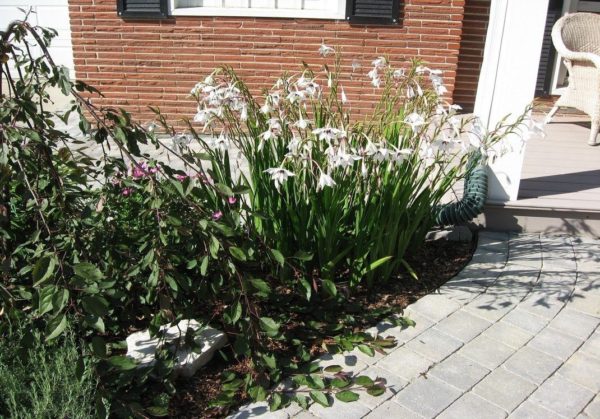
Seeds
Like many bulbous, fragrant gladioli can be grown from seeds. Occupation is time-consuming, lengthy, and very amateur. Although it has advantages: plants grown from seeds collected by hand will be more hardened, strong and adapted to local conditions.
Seed collection - in the fall. Seeds are sown in seedlings in early February, kept at ordinary room temperature + 20 ° C. Necessarily illumination, otherwise the plants will stretch. Small plantlets dive into separate containers, several each. You can drop them into the ground.
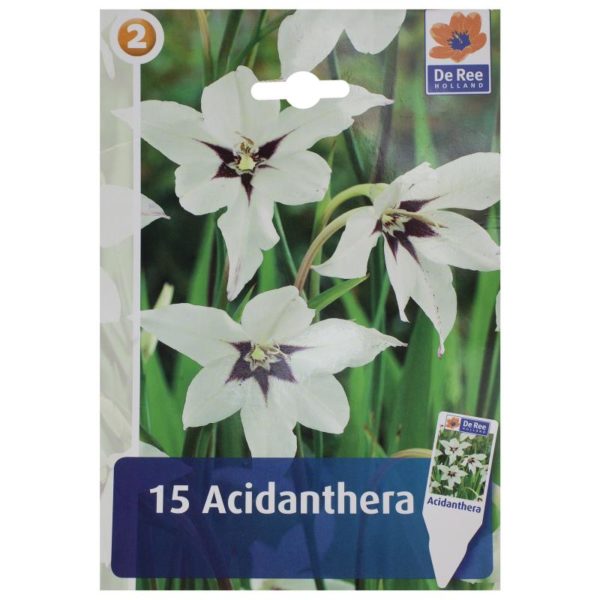
Species and varieties
Since the taxonomy of the species to date has been rather confusing, there are many synonymous names: Acidanthera bicolor Hochst. and Acidanthera bicolor var. murielae (Acidantera bicolor and Acidantera Muriela are one and the same). From a botanical point of view, synonyms for them are Gladiolus callianthus Marais (Gladiolus beautiful flowers, or callianthus), Ixia quartiniana (Ixia quartiniana A.Rich). This confusion is due to the fact that descriptions of the same plant were performed by different botanists, in different places, at different times.
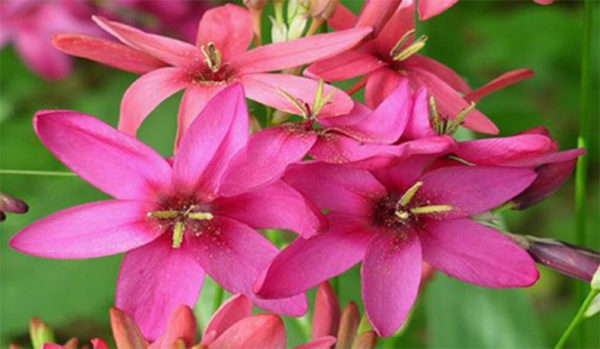
In our country, it is grown, as a rule, namely Acidether Bicolor or Muriel. On the packaging of onions on sale you can find the names: Two-color white, Muriela, Muriel, Two-color.This is all one and the same variety.
In addition to the two-color acidanthera, today in the gardens of especially thin connoisseurs you can find:
- A. white (Acidanthera white) - medium-sized flowers with rounded petals, pure white, no spots, very fragrant. This is the most odorous type of acidanthera. Today, this plant is classified as gladiolus white.
- A. Fourcade. The plant is relatively low, with thin stems. The flowers are pink-purple almost uniform in color, with a thickening to the edges, without spots. On one peduncle there are only two flowers, but they are charming. Today the plant was renamed the Fourcade geysoriza.
- A. tropical. A powerful plant with ribbed foliage, very tall - up to 130 cm. The flowers are original, snowy white or pinkish, with very bright raspberry brush strokes-prints, as if painted with watercolors. The flowers are larger than in other species, collected in inflorescences of 5-6 pieces. Outwardly very similar to gladiolus is the nanus of the Nymph or Prince Klaus variety.
- A. Cape (or panicled ixia - Ixia paniculata). It has very beautiful flowers: white with purple streaks instead of spots.
- A. grass-leaved. The most elegant representative of the genus, with thin narrow foliage, as in cereal plants, and the same flowers with narrow, elongated petals. Coloring - pale pink with a purple stripe in the center of each petal. Peduncles long drooping. Today, this type of acidanthera belongs to the form of gladiolus abundantly flowering. A. malocotsvetnoy also belong here. It is very similar to grassy, only the flowers are red, not purple.
- A. tubular or, as it is classified today, geysoriza stemless. The flowers are similar to the flowers of the acanthera of the leafy, with the same narrow, elongated petals, in color they resemble Fourcade - a delicate pink color with slight condensation to the edges.
You can find other names: broad-leaved (with very wide perianths, which makes the flowers look like orchid flowers), pink and white (a huge rarity).
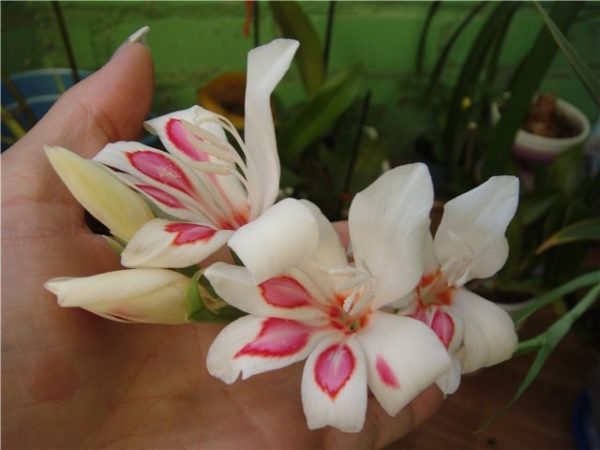
Diseases and Pests
The plant is quite resistant to diseases and pests. In adverse conditions, it can be affected:
- Bulbous tick.
- Scaffolds.
- Aphids.
- Thrips.
- Slugs.
- Powdery Mildew
- Rust.
- Root rot.
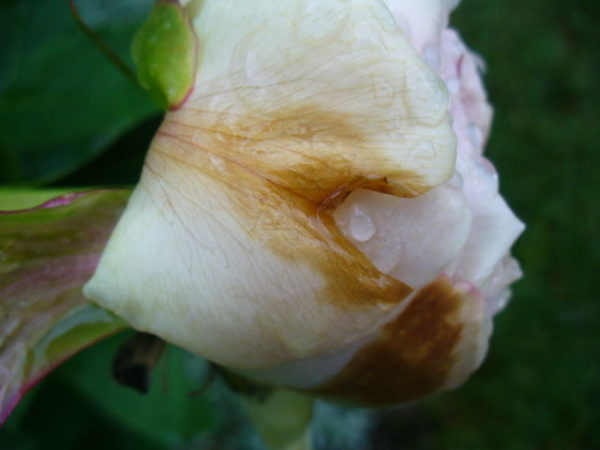
Prevention measures: the right choice of place, good drainage, lack of stagnation of moisture in wet summers, timely removal of weeds, proper pre-planting treatment (bulbs are treated with fungicides, growth and immunity stimulants).
Acidanthera in landscape design
Even a non-flowering plant is effective and perfectly suited for creating dynamic vertical accents. The flowering bush looks even more impressive, therefore it is self-sufficient. Groups of fragrant gladioli look great solos, surrounded by low-growing small-flowering or not at all flowering plants, or a lawn.
Acidanthera would be appropriate:
- In flower beds as a dominant.
- Groups on the background of ground cover or undersized plants, lawns.
- Thanks to the aroma, it is suitable for decorating relaxation areas.
- In the front gardens, compositions in front of the house, along paths, especially paved with stone.
- On the alpine roller coaster. The birthplace of the plant is rocky plateaus.
- Near decorative artificial reservoirs.
- In gardens of the Japanese or English style, flowers acidants are refined and distinguished.
- In monogroups. The islands of fragrant gladioli near the entrance to the house, on the flower beds during the flowering period, look grandiose and at the same time gentle, like flocks of butterflies.
It can be grown in room and container culture. Flowers are suitable for cutting, stand up to 5 days.
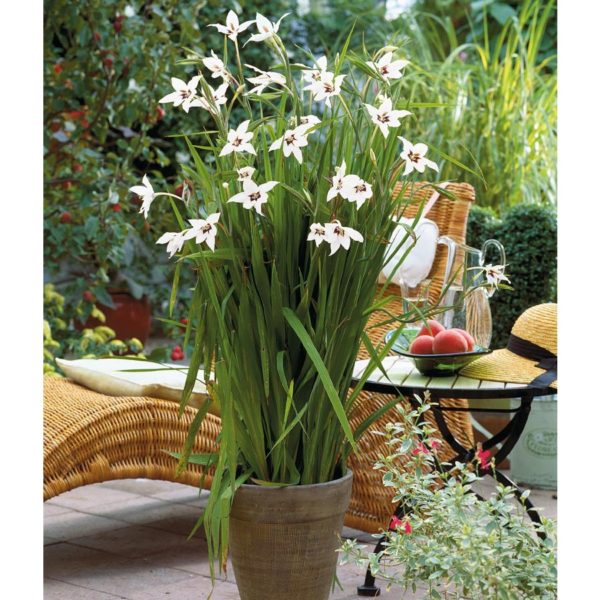
It goes well with:
- Low-growing garden flowers, creating a good dense cover: balsamines, daisies, stunted asters.
- Any flowers of blue and violet colors that emphasize the exotic tenderness of fragrant gladiolus: sage, aconite (remember that aconites are poisonous).
- Any flowers, in the appearance of which there is something primordial, evoking associations with a flowering meadow, preferably bright raspberry shades: monard, emilia.
- Cereals and plants of the Alpine hills: cornflower, foxtail.
The price of corms is democratic, 100-150 rubles. per pack 10 pcs. Buying planting material of this sophisticated, delicate and exotic flower is not difficult today - it is offered by both importers of foreign planting material and domestic nurseries.

